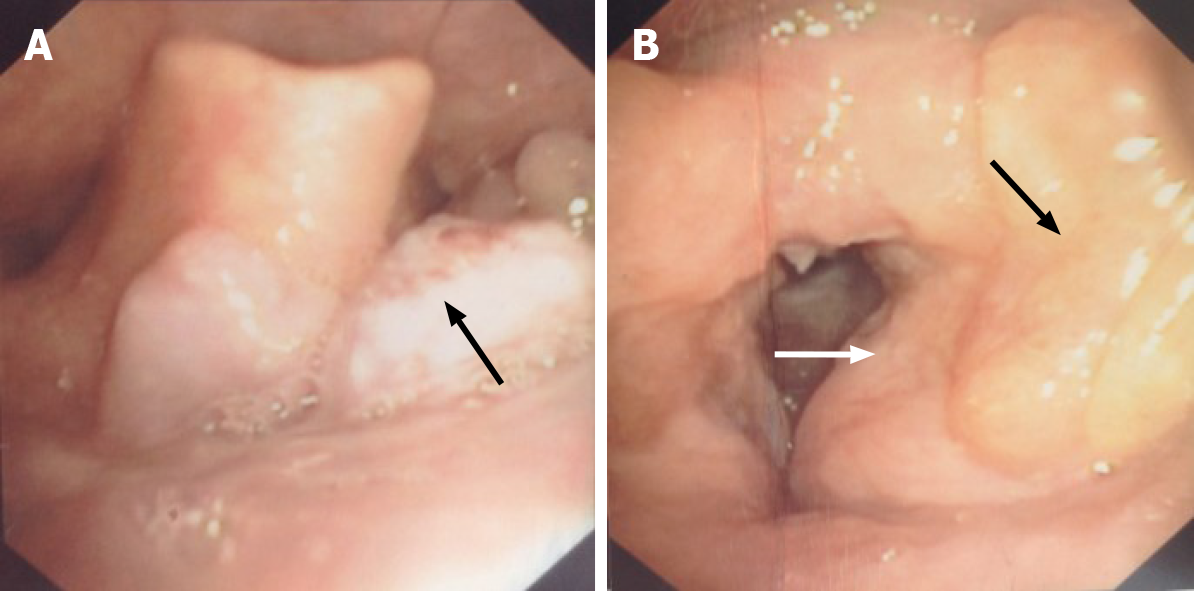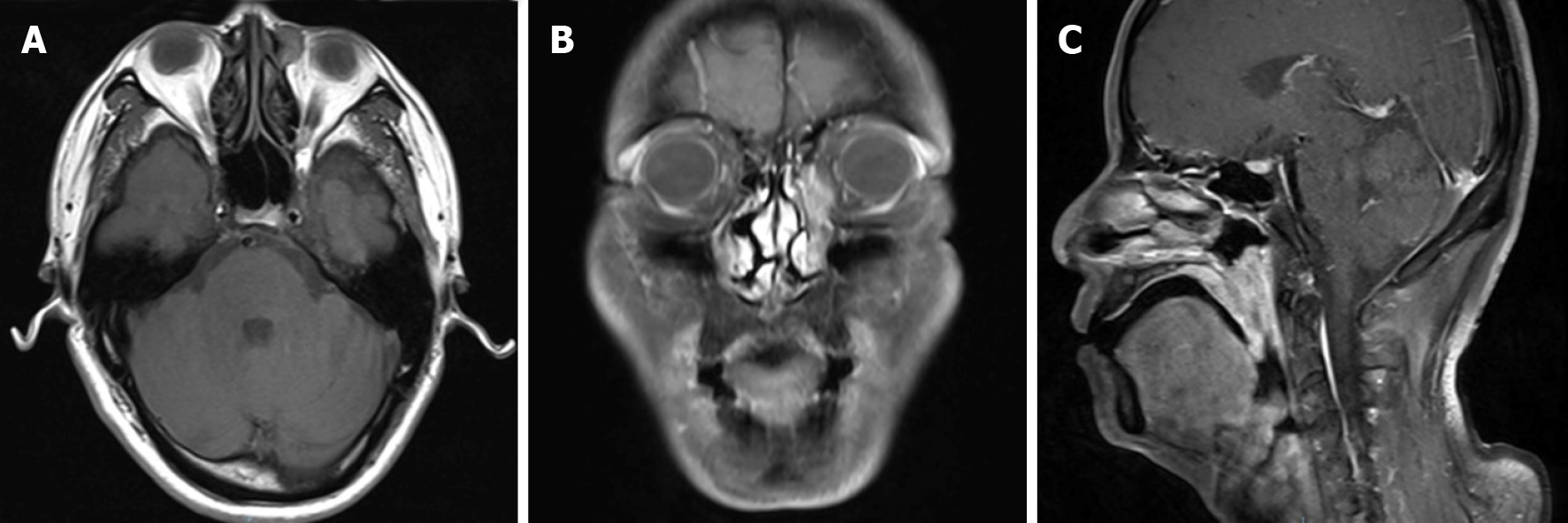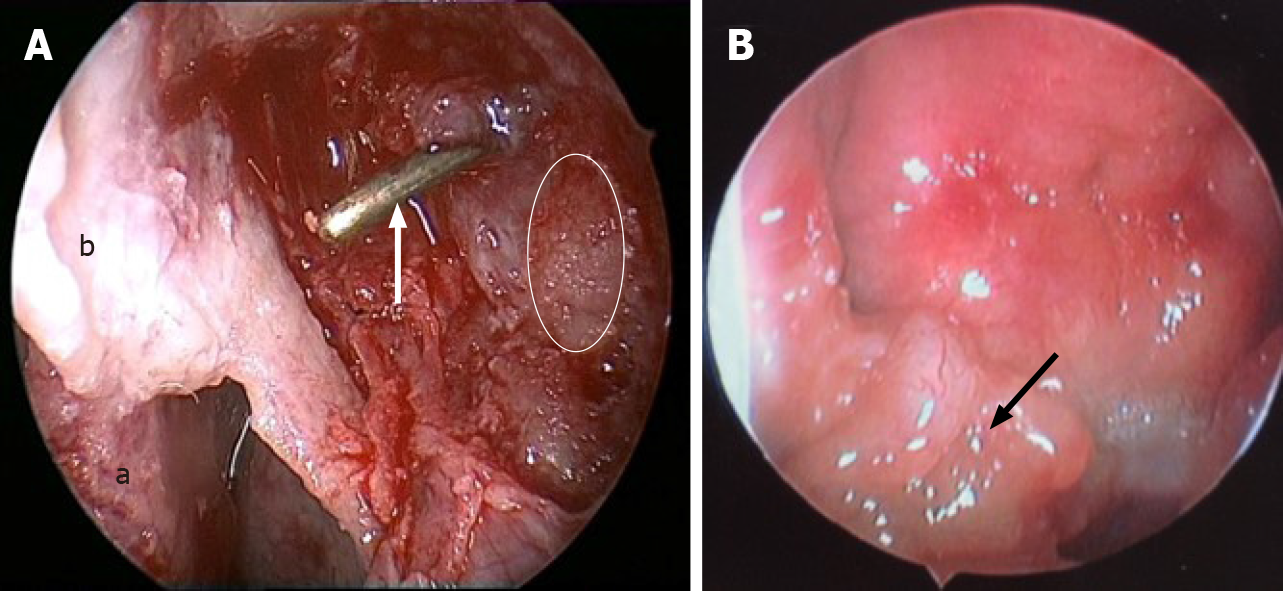Published online Nov 26, 2020. doi: 10.12998/wjcc.v8.i22.5684
Peer-review started: June 18, 2020
First decision: September 23, 2020
Revised: October 1, 2020
Accepted: October 20, 2020
Article in press: October 20, 2020
Published online: November 26, 2020
Processing time: 160 Days and 13.2 Hours
Here we present a rare case of localized amyloidosis involving the nasolacrimal duct and lacrimal sac which was managed by endoscopic surgery.
A 50-year-old man whose medical history included bilateral ventricular fold and vocal cord amyloidosis complained of bilateral epiphora. Magnetic resonance imaging revealed a neoplasm within the nasolacrimal sac. Characteristic positivity for Congo red staining and birefringence under a polarized microscope proved the diagnosis of amyloidosis. Dacryocystorhinostomy via an endoscope obtained a favorable result. A one-year follow-up found no recurrence.
There are few reports on amyloidosis involving the lacrimal outflow system, and management and outcome are not clear. Endoscopic dacryocystorhinostomy can be a choice to relieve symptoms. Regular follow-up and monitoring of systemic diseases are highly recommended.
Core Tip: A 50-year-old man was admitted with bilateral epiphora for 2 years and an enlargement of the lacrimal sac in his left eye for 3 mo. His medical history included bilateral ventricular fold and vocal cord amyloidosis followed by a neoplasm of the tongue base. Pathological examinations showed positive congo red staining with apple-green birefringence under polarized light. Endoscopic left dacryocystorhinostomy was performed to remove the mass in the nasolacrimal duct and lacrimal sac and achieved no recurrence during 1-year follow-up. Regular follow-up and monitoring of systemic diseases are highly recommended.
- Citation: Song X, Yang J, Lai Y, Zhou J, Wang J, Sun X, Wang D. Localized amyloidosis affecting the lacrimal sac managed by endoscopic surgery: A case report. World J Clin Cases 2020; 8(22): 5684-5689
- URL: https://www.wjgnet.com/2307-8960/full/v8/i22/5684.htm
- DOI: https://dx.doi.org/10.12998/wjcc.v8.i22.5684
Amyloidosis is an idiopathic group of diseases presenting with extracellular deposition of misfolded proteins, forming proteinaceous, amorphous material within connective tissues. Amyloidosis occurs in systemic or localized forms[1]. Localized amyloid, which is rare, most commonly deposits in the head and neck region, and is characterized by an excellent prognosis. The most commonly reported head and neck amyloidosis is localized in the larynx. Orbital involvement cases are not extremely rare except those affecting the lacrimal sac.
This report presents a rare case of amyloidosis localized to multiple head and neck locations (the larynx, tongue, trachea, nasopharynx, oropharynx, uvula, and eventually bilateral nasolacrimal duct) without evidence of familial heredity or systemic disease. To our knowledge, nasolacrimal duct involvement by amyloidosis has been previously reported in only three articles[2-4], and this is the first case to make exploration via endoscopic approach.
Bilateral epiphora for 2 years.
A 50-year-old man presented with a 2-year history of bilateral epiphora, deteriorating in recent 3 mo, with an enlargement in the area overlying the lacrimal sac in his left eye. No eye pain, erythema, impaired vision, or purulent discharge from the puncta was presented. Previous irrigation of the lacrimal systems and eyedrop treatment made no improvement.
His medical history included bilateral ventricular fold and vocal cord amyloidosis treated by a microlaryngoscopic surgery 2 years ago, followed by a neoplasm of the tongue base 9 mo later (Figure 1). He had undergone another microlaryngoscopic surgery to clear amyloid deposits under the mucosa of the tongue.
On examination, there was a firm mass on palpation in the area of the left lacrimal sac externally. The visual acuity was 1.2/OU. Intraocular pressures, motility, pupils, and other ophthalmologic examinations were normal except an elevated tear meniscus in bilateral eyes (especially the left eye) and irrigation of the lacrimal duct showed complete left nasolacrimal duct obstruction (NLDO).
The patient was referred to a hematologist after the final surgery to undertake extensive hematologic and systematic studies. No monoclonal protein expression was found in immunofixation electrophoresis of urine and serum, and the sensitive quantitative serum free light chain assay showed normal results. An abdominal fat pad aspirate found no amyloid deposits. The patient’s echocardiogram and chest X-ray showed no evidence of parenchymal or cardiac disease.
Magnetic resonance imaging (MRI) revealed extensive soft tissue thickening in the posterior and lateral wall of the nasopharynx, and the lateral wall of the oropharynx and uvula. A soft tissue intensity mass was observed within the left nasolacrimal sac (Figure 2). There was no sign of previous lacrimal system injury from last two surgeries.
The diagnosis of amyloidosis was proved by pathological examination. Specimens of these friable tissues were submitted for histopathologic examination, which showed the masses to be fibrous tissue with dense amyloid deposition. On hematoxylin and eosin staining, pink amorphous deposits were noted in the submucosa under the pseudostratified nonkeratinized epithelial mucosa (Figure 3A). Under polarized light, amyloid staining showed typical positive Congo Red staining with apple-green birefringence (Figure 3B and C). Immunohistochemistry study was performed to investigate the composition of the amyloid material (Figure 3D).
Subsequently, the patient underwent endoscopic left dacryocystorhinostomy and resection of multiple masses.
Intraoperatively, we found friable yellowish masses in the basis nasi and bilateral posterior naris, with involvement of the right torus, nasopharynx, uvula, and oropharynx. The nasolacrimal duct was filled with similar yellowish sediment, as well as lacrimal sac (Figure 4). After the endoscopic surgery, no macroscopic residual lesions remained.
One week after operation, the patient’s left eye was freely irrigated in the examination of the inferior punctum by syringing, however, the right eye presented mucous reflux on irrigation and was partially obstructed. Endoscopic follow-up at 1 year after surgery showed well healing of the wounds, without adhesion or sign of recurrence or obstruction of the lacrimal sac. No sign of mass obstructing the nasolacrimal duct or other lesions was noted on computed tomography (CT) 1 year later.
Amyloidosis refers to the idiopathic, extracellular deposition of fibrillar proteins in tissues, sharing a common feature: Misfolded proteins with a beta-pleated-sheet structure. According to modern classification of amyloidosis based on the nature of the precursor plasma proteins, there are three most common forms of amyloidosis, namely, AL (immunoglobulin light chain as precursor), AA (serum amyloid A), and ATTR (transthyretin)[1]. In this case, the immunohistochemistry showed the precursor to be lambda light chain.
Localized amyloidosis is relatively rare. The plasma cells producing abnormal proteins are limited to the tissues rather than in the bone marrow. The larynx (60%) is the most common site of amyloid deposition in the head and neck, followed by the trachea (9%), orbit (4%), and nasopharynx (3%)[5]; however, larynx deposition is rarely a component of systemic amyloidosis[6-8]. Only 4% of cases of focal amyloidosis involving the head and neck region occur in the orbit[9], which often include amyloid infiltration of the lacrimal gland, extraocular muscle, orbital fat, and even optic nerve[10-15]. However, nasolacrimal duct or lacrimal sac involvement is hardly reported. The first literature regarding the lacrimal outflow system was reported by
Not all head and neck amyloidosis cases are related to a systemic disorder, but 90% of patients with systemic amyloid will develop amyloid deposits in the upper aerodigestive tract[6]. So it is more than necessary to evaluate for systemic condition, which may exclude malignancy.
Diagnosis of amyloidosis depends on biopsies of specific organs or tissues, because imaging findings of amyloidosis are various and nonspecific[3,16,17]. Occasionally, it mimics localized or widespread carcinoma with lymph node metastasis when a neck mass is present[17]. CT and MRI are both used to evaluate the extent of amyloid, but some demonstrated that CT imaging shows calcifications better and can be more useful than MRI[9,10,12,14]. We used MRI to determine the extent of amyloid because of the previous surgery and complicated history of this patient. Diagnosis is made histochemically with characteristic positivity for Congo red staining and birefringence under a polarized microscope once systemic amyloidosis is ruled out. Treatment options including corticosteroids, radiotherapy, and agents like melphalan result in variable outcomes, but most authors believe that for localized amyloidosis, surgery for symptomatic relief is a favorable choice[18-20].
Although bilateral eyes both presented with epiphora in this patient, we find no significant lesion on the right eye in both endoscopic examination and MRI. Surgery was carried out only on the left eye, which had more severe symptoms. Surgery turned out to be effective, and the right eye had not been deteriorated so far.
Different recurrent rates for local head and neck amyloidosis were reported. Heinritz et al[21] reported complete excision without recurrence during a period of 10 years in 12 cases. Feng et al[22] reported a 20% recurrence rate 6 mo after the first surgery[22]. There is no evidence of localized amyloid progressing to develop systemic malignancy, but an underlying malignancy should call concern in the case of amyloidosis of head and neck mucosal sites excluding the larynx[6,7,23,24]. The prognosis is uncertain owing to the rarity of the condition, and we cautiously recommend regular follow-up and monitoring.
We have reported a patient with bilateral NLDO whose amyloidosis initiated from larynx, extended to the tongue, trachea, and nasopharynx, and finally involved the lacrimal outflow system without systemic conditions. It is the first case to try endoscopic dacryocystorhinostomy in treating NLDO caused by localized amyloidosis, and the outcome proved to be satisfactory in a one-year follow-up. Regular follow-up and monitoring of systemic diseases are highly recommended.
Manuscript source: Unsolicited manuscript
Corresponding Author's Membership in Professional Societies: Chinese Medical Association.
Specialty type: Medicine, research and experimental
Country/Territory of origin: China
Peer-review report’s scientific quality classification
Grade A (Excellent): 0
Grade B (Very good): 0
Grade C (Good): C
Grade D (Fair): 0
Grade E (Poor): 0
P-Reviewer: Tantau AI S-Editor: Zhang L L-Editor: Wang TQ P-Editor: Liu JH
| 1. | Khan MF, Falk RH. Amyloidosis. Postgrad Med J. 2001;77:686-693. [RCA] [PubMed] [DOI] [Full Text] [Cited by in Crossref: 50] [Cited by in RCA: 49] [Article Influence: 2.0] [Reference Citation Analysis (0)] |
| 2. | Geller E, Freitag SK, Laver NV. Localized nasopharyngeal amyloidosis causing bilateral nasolacrimal duct obstruction. Ophthalmic Plast Reconstr Surg. 2011;27:e64-e67. [RCA] [PubMed] [DOI] [Full Text] [Cited by in Crossref: 6] [Cited by in RCA: 10] [Article Influence: 0.7] [Reference Citation Analysis (0)] |
| 3. | Marcet MM, Roh JH, Mandeville JT, Woog JJ. Localized orbital amyloidosis involving the lacrimal sac and nasolacrimal duct. Ophthalmology. 2006;113:153-156. [RCA] [PubMed] [DOI] [Full Text] [Cited by in Crossref: 19] [Cited by in RCA: 15] [Article Influence: 0.8] [Reference Citation Analysis (0)] |
| 4. | Levine MR, Seipel SB, Plesec TP, Costin BR. Amyloid Pseudo-Dacryolith and Nasolacrimal Obstruction in a 67-Year-Old Male. Ophthalmic Plast Reconstr Surg. 2017;33:e86-e88. [RCA] [PubMed] [DOI] [Full Text] [Cited by in Crossref: 5] [Cited by in RCA: 6] [Article Influence: 0.8] [Reference Citation Analysis (0)] |
| 5. | Karimi K, Chheda NN. Nasopharyngeal amyloidosis: a case report. Laryngoscope. 2010;120 Suppl 4:S197. [RCA] [PubMed] [DOI] [Full Text] [Cited by in Crossref: 5] [Cited by in RCA: 5] [Article Influence: 0.4] [Reference Citation Analysis (0)] |
| 6. | Lebowitz RA, Morris L. Plasma cell dyscrasias and amyloidosis. Otolaryngol Clin North Am. 2003;36:747-764. [RCA] [PubMed] [DOI] [Full Text] [Cited by in Crossref: 36] [Cited by in RCA: 31] [Article Influence: 1.4] [Reference Citation Analysis (0)] |
| 7. | Thompson LD, Derringer GA, Wenig BM. Amyloidosis of the larynx: a clinicopathologic study of 11 cases. Mod Pathol. 2000;13:528-535. [RCA] [PubMed] [DOI] [Full Text] [Cited by in Crossref: 97] [Cited by in RCA: 72] [Article Influence: 2.9] [Reference Citation Analysis (0)] |
| 8. | Pribitkin E, Friedman O, O'Hara B, Cunnane MF, Levi D, Rosen M, Keane WM, Sataloff RT. Amyloidosis of the upper aerodigestive tract. Laryngoscope. 2003;113:2095-2101. [RCA] [PubMed] [DOI] [Full Text] [Cited by in Crossref: 73] [Cited by in RCA: 55] [Article Influence: 2.6] [Reference Citation Analysis (0)] |
| 9. | Gean-Marton AD, Kirsch CF, Vezina LG, Weber AL. Focal amyloidosis of the head and neck: evaluation with CT and MR imaging. Radiology. 1991;181:521-525. [RCA] [PubMed] [DOI] [Full Text] [Cited by in Crossref: 91] [Cited by in RCA: 83] [Article Influence: 2.4] [Reference Citation Analysis (0)] |
| 10. | Leibovitch I, Selva D, Goldberg RA, Sullivan TJ, Saeed P, Davis G, McCann JD, McNab A, Rootman J. Periocular and orbital amyloidosis: clinical characteristics, management, and outcome. Ophthalmology. 2006;113:1657-1664. [RCA] [PubMed] [DOI] [Full Text] [Cited by in Crossref: 88] [Cited by in RCA: 102] [Article Influence: 5.4] [Reference Citation Analysis (0)] |
| 11. | Savino PJ, Schatz NJ, Rodrigues MM. Orbital amyloidosis. Can J Ophthalmol. 1976;11:252-255. [PubMed] |
| 12. | Murdoch IE, Sullivan TJ, Moseley I, Hawkins PN, Pepys MB, Tan SY, Garner A, Wright JE. Primary localised amyloidosis of the orbit. Br J Ophthalmol. 1996;80:1083-1086. [RCA] [PubMed] [DOI] [Full Text] [Cited by in Crossref: 45] [Cited by in RCA: 49] [Article Influence: 1.7] [Reference Citation Analysis (0)] |
| 13. | Cheng JY, Fong KS, Cheah ES, Choo CT. Lacrimal gland amyloidosis. Ophthalmic Plast Reconstr Surg. 2006;22:306-308. [RCA] [PubMed] [DOI] [Full Text] [Cited by in Crossref: 10] [Cited by in RCA: 17] [Article Influence: 0.9] [Reference Citation Analysis (0)] |
| 14. | Okamoto K, Ito J, Emura I, Kawasaki T, Furusawa T, Sakai K, Tokiguchi S. Focal orbital amyloidosis presenting as rectus muscle enlargement: CT and MR findings. AJNR Am J Neuroradiol. 1998;19:1799-1801. [PubMed] |
| 15. | Lawton AW, Leone CR Jr, Hunter DM. Optic nerve pseudomeningioma secondary to localized amyloidosis. Ophthalmic Plast Reconstr Surg. 1989;5:52-55. [RCA] [PubMed] [DOI] [Full Text] [Cited by in Crossref: 5] [Cited by in RCA: 6] [Article Influence: 0.2] [Reference Citation Analysis (0)] |
| 16. | Chin SC, Fatterpeckar G, Kao CH, Chen CY, Som PM. Amyloidosis concurrently involving the sinonasal cavities and larynx. AJNR Am J Neuroradiol. 2004;25:636-638. [PubMed] |
| 17. | Zhuang YL, Tsai TL, Lin CZ. Localized amyloid deposition in the nasopharynx and neck, mimicking nasopharyngeal carcinoma with neck metastasis. J Chin Med Assoc. 2005;68:142-145. [RCA] [PubMed] [DOI] [Full Text] [Cited by in Crossref: 13] [Cited by in RCA: 13] [Article Influence: 0.7] [Reference Citation Analysis (0)] |
| 18. | Naidoo YS, Gupta R, Sacks R. A retrospective case review of isolated sinonasal amyloidosis. J Laryngol Otol. 2012;126:633-637. [RCA] [PubMed] [DOI] [Full Text] [Cited by in Crossref: 10] [Cited by in RCA: 12] [Article Influence: 0.9] [Reference Citation Analysis (0)] |
| 19. | Avitia S, Hamilton JS, Osborne RF. Surgical rehabilitation for primary laryngeal amyloidosis. Ear Nose Throat J. 2007;86:206, 208. [PubMed] |
| 20. | Feingold RM. Laryngeal amyloidosis. J Insur Med. 2012;43:32-35. [PubMed] |
| 21. | Heinritz H, Kraus T, Iro H. [Localized amyloidosis in the area of the head-neck. A retrospective study]. HNO. 1994;42:744-749. [PubMed] |
| 22. | Feng Y, Xi L, Yu X, He G. [Analysis of clinical manifestations of rhinal and pharyngeal and laryngeal amyloidosis by 12 cases]. Lin Chung Er Bi Yan Hou Tou Jing Wai Ke Za Zhi. 2011;25:1115-1117. [PubMed] |
| 23. | Patrinely JR, Koch DD. Surgical management of advanced ocular adnexal amyloidosis. Arch Ophthalmol. 1992;110:882-885. [RCA] [PubMed] [DOI] [Full Text] [Cited by in Crossref: 23] [Cited by in RCA: 23] [Article Influence: 0.7] [Reference Citation Analysis (0)] |
| 24. | Penner CR, Muller S. Head and neck amyloidosis: a clinicopathologic study of 15 cases. Oral Oncol. 2006;42:421-429. [RCA] [PubMed] [DOI] [Full Text] [Cited by in Crossref: 72] [Cited by in RCA: 60] [Article Influence: 3.2] [Reference Citation Analysis (0)] |












